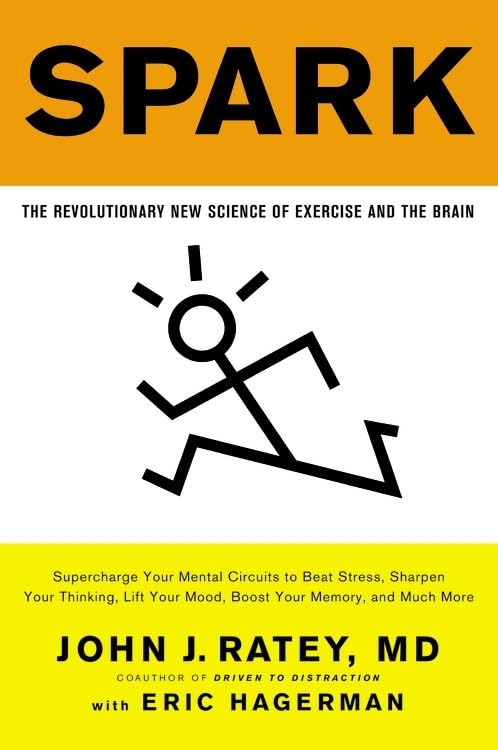Price: $19.99 - $11.19
(as of Jul 06, 2024 11:36:29 UTC – Details)
A groundbreaking and fascinating investigation into…
Customers say
Customers find the content very enlightening and informative. They also describe the book as concise, sincere, and dynamic. Readers mention that the book makes them feel good and improves their overall mood. They appreciate the author’s section on sobriety.
AI-generated from the text of customer reviews



















Kristen Anne Hall –
I’ve got get back into my exercise groove
I read this book for an awesome grad school course with the University of Texas School of Public Health, Austin Regional Campus: PH 2998 – Seminar in Child and Adolescent Health taught by Dr. Steve Kelder. Part of our assignment was a book report and then an Amazon posting:Dr. John Ratey is an Associate Professor at Harvard Medical School as well as a practicing psychiatrist. He has been well known and respected in his field since the late 1990s and has published many books on various psychiatric topics. This book is a compilation of personal experience, scientific knowledge and studies, as well as case studies that involve exercise and how the brain responds. Dr. Ratey wants to share the information he has gathered and the benefits he has both witnessed and experienced in regards to exercise and brain function. He wants everyone to be able to tap into their best self, both physically and mentally.This book is very accessible for both the scientifically trained and the lay reader. Dr. Ratey explains some basics of neurobiology and brain chemistry in simple enough terms and frequently comes back to each explanation in each chapter so readers do not have to worry about memorizing the exact details of each study and concept – and by the end, many will stick to the readerâs strengthened neural circuitry due to such repetition and re-emphasis.Dr. Ratey focuses on eight very important topics in psychiatry and how they can be improved with exercise – learning, stress, anxiety, depression, attention, addiction, hormones, and aging. Each chapter gives a case study or two, some anecdotal evidence from his experiences and practice, as well as robust scientific findings and experimental outcomes supporting. It was extremely straightforward and easy to read for me.Here is a basic summary of each topic, each its own chapter:Learning is fueled by the building of new synapses and new cells in the brain. This is greatly driven by brain-derived neurotrophic factor (BDNF) which Dr. Ratey considers âmiracle-groâ for the brain. He discusses how exercise stimulates and supports the production of BDNF and thus helps the creation and growth of new brain cells. Exercise also has proven impacts on alertness, attention, and motivation, all necessary for learning. Lastly, exercise helps with chemical factors that build and strengthen synapses (connections between nerve cells).Stress is something that is ubiquitous in modern culture. It erodes our physical and mental health and creates elevated risk for many diseases. Frequent exercise is something we donât feel we have time for, something that we assume will just stress us out more, however, Dr. Ratey counters that some stress is good – it stimulates our bodies to renew and strengthen itself, exercise is a very good stress. It puts us in control of our bodies and our minds, and by extension our lives. The stress of exercise inoculates us against future stressful situations and trains our bodies to respond in less harmful ways. Frequent exercise primes us to fight stress and fight it appropriately.Anxiety is often a product of the hypersensitive nervous system and disrupted brain chemistry. In many situations it must be controlled with medications and therapy to reduce panic attacks. Many anxiety medications have concerning side effects. Dr. Ratey explains that exercise can work as well or better than medication, or alongside medication, to help people control their anxiety, panic, and fear. Exercise is able to create a distraction from anxiety, reduce muscle tension, properly build up the brainâs chemical resources, create a different outcome than panic attack, and reroute circuits in the brain. This to builds resilience to and hopefully growing freedom from anxiety and fear.Depression is another major issue tackled by Dr. Ratey. Just as with anxiety disorders, medications to treat depression have intense and unwanted side effects and individuals have great variance in whether a medication even works for them. While depression is something that often makes people unwilling to exercise, if they can make the first step to try it and a concerted effort to keep going they can have great results. Exercise balances many neurotransmitters that are out of whack in the depressed brain and can even repair structural damage that is apparent in many patients. This is a disease that can often be impacted one step at a time, literally.Dr. Ratey, has addressed attention disorders in several of his previous books. He has great insight and knowledge on the subject and now has increasing evidence that daily exercise is an effective treatment for many people with a spectrum of attention disorders. Personally, I have often thought that I am borderline ADHD, so this chapter was extremely insightful an impactful to me. It made me thankful that I had always been active and athletic as a child so I was not greatly impacted in school. Now in grad school, however, I should really step up my exercise routine again, rather than letting it slip as much as I have. Just as stated the learning chapter, exercise helps with alertness, motivation, and attention. It balances out neurotransmitters and helps the brain self-regulate for a time after moderate to vigorous activity.Another major topic was addiction. The impactful parts of this chapter were how some addicts were able to recover and retrain their brains with running programs incorporated in their treatment programs. There is a team of former addicts who now runs marathons together. They have found a way out of their addictions, learned to control their brain chemistry, and found a way to reconnect with others, rather than be marginalized. Dr. Ratey mentions in this chapter as well as others, how exercise can be even more beneficial as a social activity. In this case the social aspect helps former addicts reconnect as well as discuss their challenges and find support.Hormones, specifically the female hormonal cycle and associated disorders, are something that is also greatly impacted by exercise. Hormones are regulated in the brain as well as effect the brain, in particular the mood center, so exercise can be a form of treatment for many âfemale issuesâ such as PMS, pregnancy, postpartum depression, and menopause. This is great news for many women who suffer, some often and some at one time or another, from these common issues. While exercise may not always be a âcureâ, Dr. Ratey emphasizes that it is something that can be started slowly and has very little risk or side effects as compared to other common treatments for hormone challenges, disruptions, and disorders.Lastly, Dr. Ratey discusses aging – both the general effects of aging on the brain as well as brain disease and disorder associated with aging (eg. dementia and Alzheimerâs). Regular exercise not only helps aging populations stay healthy and âfeel youngerâ but also helps their brains stay markedly younger. There are physical and chemical effects in the brain itself that can greatly impact how gracefully someoneâs brain ages. People who stay sharp, wise, and alert as they age are often regular exercisers, sometimes by recommendation of their doctors, but most often by habit and personal knowledge. Studies now support the creation of these habits. We can prevent the degeneration of our minds by exercising now and creating a habit of it to cary us through old age.This book has great implications for a current topic of study for me: child and adolescent heath. It reinforces that we must have quality physical education programs that encourage children and teens to have healthy habits and find a fitness routine that works for them. I am encouraged by Dr. Rateyâs introduction with âNew PEâ that is based on lifetime fitness and creating a new core subject. This book and suggestions in it can especially help children and teens dealing with issues of depression, anxiety, stress, and attention.And now weâve all got to get out there and MOVE!
Ann –
My Opinion on Book Content and Style
I am writing this review in order to provide an in-depth criticism on the book’s content as well as structure for people who are deciding whether or not to purchase this book.I enjoyed the read. As an avid marathoner, I am constantly looking for literature that tells me that all the torture I put my body through is worth it. Being a medical doctor, John Ratey has hands-on experience and knowledge with diagnosis and prescription of treatments. He has seen how exercise can solve health issues in lieu of medications. His perspective on the topic allows him to write effectively. He has obviously researched the effects of exercise on the brain to a great extent – and he does a great job of introducing the reader to the science and explaining why it matters. He covers the effects of exercise on the following: learning, stress, anxiety, depression, attention deficit, addiction, hormonal changes, and aging. Each of these topics are very relevant to the modern human. Personally, I enjoyed reading the learning and stress chapters the most. Ratey wrote the book to promote exercise, and he constantly reminds the reader of it. He eloquently ties all the information of a chapter together to support his message: exercise is good for you.The first chapter, “Welcome to the Revolution”, describes recent innovation in Physical Education classes in grade schools in America. Ratey tells an interesting story about the schools of Naperville, Illinois and the instigator of the PE rebellion, Phil Lawler. Mr. Lawler’s story is fascinating. His desire to rework the PE curriculum and his success in doing so is admirable, but even more exciting are the results from that passion. Naperville’s District 203 had some of the highest average test scores in the world, including 6th in the world for math and 1st in the world for science. Ratey uses this chapter to show how this isn’t a simple correlation between increased fitness and higher test scores. He provides many examples as well as statistics to show that physical education has a very important place in the lives of Americans.The second chapter, “Learning”, sets out to demonstrate to the readers how exercise affects the way we learn. In this chapter, Ratey introduces neuroplasticity, neurotransmitters, and neurotrophic factors. He describes the terms without using confusing medical jargon. Notably, he teaches the reader about Brain Derived Neurotrophic Factor (BDNF) and how it influences learning. Exercise stimulates the production of BDNF. Ratey mixes the science with real-life examples so it is easy to understand.The third chapter, “Stress”, goes over the mechanisms of stress within the body and how exercise acts as a counter to excess stress. He uses a patient of his, Susan, as a point of reference throughout the chapter, applying new topics to Susan’s situation and the outcome of those changes. I found it very useful to be able to come back to Susan and see how she changed as Dr. Ratey “prescribed” exercise to deal with stress. Ratey goes over what stress is and how it affects the body. This is very useful because not many people understand how debilitating stress can be and how important it is to have an outlet for reducing it. As Ratey explains, stress equals higher levels of cortisol in the body. Cortisol in high levels will damage the body, including the brain, but it is absolutely essential in controlled doses. Ratey does a fantastic job of explaining the complex interaction between the brain, the body, and stress.The fourth chapter, “Anxiety”, describes how exercise affects anxiety. Ratey provides the reader with a simple and in-depth explanation of how anxiety is produced within the body. Shortly after, the reader finds out how exercise affects that state of anxiety and reduces it. It is very easy to throw out physiological terms and leave the readers with abstract ideas of what is happening in the body, but Ratey explains it well enough so the reader is not lost.In order to maintain some degree of mystery in the book, I will briefly skim over the remaining chapters. Chapter 5 “Depression” is an extremely useful chapter, as many people in the United States suffer from depression. Exercise has many benefits – and helping cope with depression is one of them. Ratey describes why and how exercise helps with depression. Chapter 6 “Attention Deficit” goes over the current epidemic of ADHD within the U.S. Ratey explains that it isn’t a simple motivation issue, but a serious physiological one. Ratey explains what is deficient in the brains of people with ADHD. He describes how brain function is affected and how neurotransmitters are as well. Of course, he ties it back to exercise. Through case studies and reports, he explains effectively how the effects produced through exercise aid those with ADHD. Chapter 7 “Addiction” covers how addiction works in our brains and how exercise works in helping overcome addictions. There are many accounts of people getting through smoking or other addictions. I found this chapter to be inspiring and educational. Chapter 8 “Hormonal Changes” is specifically written for women. It goes through how hormones affect women throughout their lives and how exercise helps balance their system. Ratey covers PMS and menopause, giving thorough descriptions of what is happening physiologically. He then describes the counteracting effects of exercise. In Chapter 9 “Aging”, Ratey explains what happens physiologically through the aging process. Again, he shows how consistent exercise can restrict the effects of aging and how it can improve brain function even in old age. He also advocates mental exercise as well as physical to restrain the effects of aging. Finally, the last chapter “The Regimen” offers advice for starting an exercise habit. It’s a useful chapter, as Ratey offers basic tips, such as finding a group to exercise with.Ratey does a fantastic job keeping the reader interested. The content is divided into ten chapters, as previously stated, and follows a predictable pattern. His writing style is simple and easy to understand. It’s not eloquent prose, but it is clear and concise and allows Ratey to deliver his message. Through his experience as a doctor, Ratey has plenty of stories for every situation. I loved reading how people’s lives changed as they simply became more active. The people in the stories were, for the most part, entirely relatable to the average person. The information about case studies and research was explained clearly and simply, so a lay person could easily grasp the meaning and importance of complex interactions and systems. I enjoyed reading this book.
Bueno en general pero el botón de mute no prende el Led. –
al cienon
Rodrigo Ramos –
Esse livro é um verdadeiro presente para os praticantes de movimento e atletas em geral, uma vez que ele explica em detalhes muitos dos benefÃcios.
Amazon Customer –
This is a great book, it explains in detail why we should get out and exercise for body, health and soul.It explains that even some is better than none, if you have issues that make it difficult.The book answers a lot of questions I had after having a stroke at 50. I had a difficult time trying to just survive a day with a 10 year old child to look after when I got home. To figure out what to eat, what did you eat with potatoes ?? How many rolls of toilet paper do you need for 2 weeks? How do you use a washer or drier? One day I ventured out to the side walk, I was exhausted when I got back. The next day I went 2 pickets on the fence further, 2 more 2 days later. After 5 months I could walk 2 miles but that was because I pushed myself to do it. If I did not walk I I had no energy, did not function well. After a year I felt much better and was able to function much better. At 79 still walk between 2 and 4 miles 6 days a week.
Dejan Djukic –
Opens eyes and brakes some old stereotypes.
Robert Dallas –
So much information, insight, and experience to expose why you should take responsibility for looking after yourself and others, and enjoy the learning experience journey.